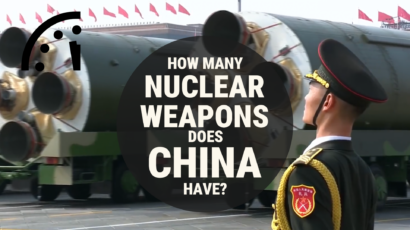Cold comfort
By Kingston Reif | August 27, 2012
As the plausible military rationales for nuclear weapons continue to deteriorate in the aftermath of the Cold War, political and psychological rationales for nuclear weapons — like providing reassurance to US allies — are increasingly viewed to be just as important as deterrence. For example, the 2009 final report of the bipartisan Congressional Commission on the Strategic Posture of the United States proclaimed: “Indeed, the assurance function of the force is as important as ever.”
The commission also argued that some US “allies believe that their needs can only be met with very specific US capabilities.” In particular, the commission highlighted the importance of nonstrategic (or “tactical”) nuclear weapons, lower-yield warheads intended for short-range applications or even battlefield use. It noted that the continued deployment of approximately 200 US nonstrategic B61 gravity bombs in Europe and the maintenance of nuclear-armed Tomahawk cruise missiles (TLAM-N) in the Pacific are essential to extending deterrence on behalf US partners in Eastern Europe and East Asia. Without these capabilities, the commission hinted, some US allies might just choose to develop their own nuclear weapons.
Critics of the continued reduction in the role and number of US nuclear weapons have latched onto these arguments in their efforts to stymie changes to US nuclear posture. For example, in this year’s House version of the defense authorization bill, Republicans included provisions that, if written into law, would predicate the withdrawal of US tactical nuclear weapons from Europe on several extreme conditions and require the Pentagon to study the potential redeployment of US tactical nuclear weapons to the Western Pacific.
While the United States should not make significant changes to its nuclear weapons policy without the input of key allies, overexaggerating the assurance value of specific nuclear capabilities risks preserving an excessive number and diversity of weapons that do not enhance deterrence, are unduly expensive, and could actually undermine alliance cohesion. A better way to provide assurance is for the United States to engage in a sustained dialogue with its allies, not only on the narrow issue of nuclear weapons, but also on how non-nuclear assurance measures can strengthen alliance ties.
Extended deterrence in Europe. The 2010 Nuclear Posture Review continued longstanding US policy by coupling extended deterrence to the maintenance of US B61 tactical nuclear weapons in Europe. NATO reaffirmed this linkage at its May summit meeting in Chicago. However, the alliance’s B61s were designed for a threat (i.e., the Soviet Union) that no longer exists, and it is nearly impossible to imagine a scenario whereby all 28 NATO allies would agree to use such weapons.
Moreover, NATO is on the verge of pricing itself out of the nonstrategic nuclear weapons market. In July, California’s Democratic Senator Dianne Feinstein announced that a new Pentagon appraisal estimated the cost of extending the B61’s lifespan at $10 billion, an increase of $6 billion over the National Nuclear Security Administration’s original estimate. Given that the rate of growth in US defense spending is likely to decline (with or without sequestration), this is an investment that Congress may not be willing to make, especially in light of the significant expenditures that will be required to replace aging strategic delivery platforms, such as ballistic missile submarines and long-range bombers.
Meanwhile, four of the five European nations that host US B61s are faced with costly decisions about whether to maintain delivery capacity by modernizing their own soon-to-be-obsolete, nuclear-capable aircraft. (Turkey is believed to have given up the nuclear delivery mission.) Germany plans to replace its Tornado IDS aircraft with the Eurofighter, which is not slated to have a nuclear capability. While Germany could maintain a small number of Tornadoes beyond their scheduled 2015 retirement, such a fix is not expected to last much beyond 2020, and few observers believe the German Parliament would finance a nuclear upgrade for the Eurofighter. Italy, the Netherlands, and Belgium are facing similar decisions and could opt to replace their nuclear-capable aircraft with the new F-35 Joint Strike fighter. However, if Germany gets out of the nuclear-capable aircraft business, the Dutch and Belgians are almost certain to follow suit. Some experts have suggested that consolidating the B61s in Italy and Turkey could serve as an alternative to complete withdrawal. However, it is unclear whether Italy and Turkey would agree to such a move.
Simply put, NATO has no choice but to begin thinking about extended deterrence in the absence of forward-deployed US tactical nuclear weapons. As I’ve written previously, the longer NATO puts off a collective decision about removing these weapons, the greater the odds that financial and political realities could force the removal of the weapons under circumstances not of its own choosing. Such an outcome could erode alliance cohesion and extended deterrence.
Extended deterrence in Asia. The United States has not deployed tactical nuclear weapons in East Asia since the end of the Cold War. The Obama administration announced that the Navy would retire the nuclear Tomahawk, which had been sitting in storage since being removed from US attack submarines in the early 1990s. This decision was made after extensive consultations with Japan and South Korea. Nevertheless, a small number of politicians in South Korea, abetted by conservative voices in the United States, are calling for the reintroduction of tactical nuclear weapons in South Korea.
China’s military modernization and North Korea’s nuclear arsenal and military provocations pose real challenges to extended deterrence. But America’s strategic nuclear forces, especially ballistic missile submarines on patrol in the Pacific, and conventional forces based in the region are more than sufficient to deter China and North Korea. Neither the South Korean government nor the US military desires to redeploy tactical nuclear weapons to South Korea. Moreover, with the retirement of the TLAM-N, the B61 is the only tactical nuclear weapon left in the US arsenal. Once again, the growing cost to extend the B61 lifespan could prove prohibitively expensive.
Tactical nuclear weapons are poor metrics of commitment. The problem with relying on tactical nuclear weapons as tools of extended deterrence is that they are archaic arms that serve no demonstrable military purpose, and their growing financial and opportunity costs outweigh any assurance benefit. In the event of a nuclear attack against an ally, the presence of these weapons on their territory will not increase the likelihood of a US nuclear response. In so far as nuclear weapons play a role in assuring allies, US strategic nuclear forces do the heavy-lifting.
The real lifeblood of extended deterrence lies in an ally’s confidence in the strength of its political relationship with the United States. If relations fray, then extended deterrence will be perceived to be weak — no matter how many or what kinds of nuclear weapons the United States possesses. Increased security cooperation with allies in the areas of conventional force projection and regional missile defense as appropriate can be particularly strong indicators of commitment given the current threat environment. So too can stronger economic and cultural ties and close coordination with allies in pursuit of better relations with Russia and China.
As long as the United States and its allies lean on outdated nonstrategic nuclear weapons as a crutch, the easier it is to avoid difficult but much needed discussions about how Washington can continue to guarantee the security of its allies — especially as geopolitical and budgetary realities compel the country to continue to reduce its reliance on nuclear weapons.
Together, we make the world safer.
The Bulletin elevates expert voices above the noise. But as an independent nonprofit organization, our operations depend on the support of readers like you. Help us continue to deliver quality journalism that holds leaders accountable. Your support of our work at any level is important. In return, we promise our coverage will be understandable, influential, vigilant, solution-oriented, and fair-minded. Together we can make a difference.
Topics: Columnists, Nuclear Weapons















